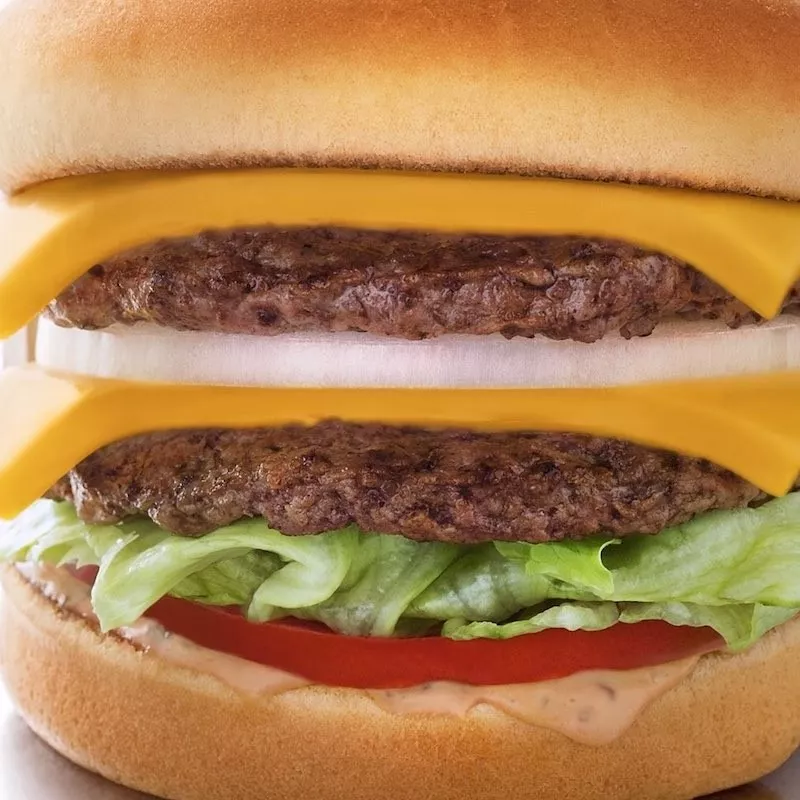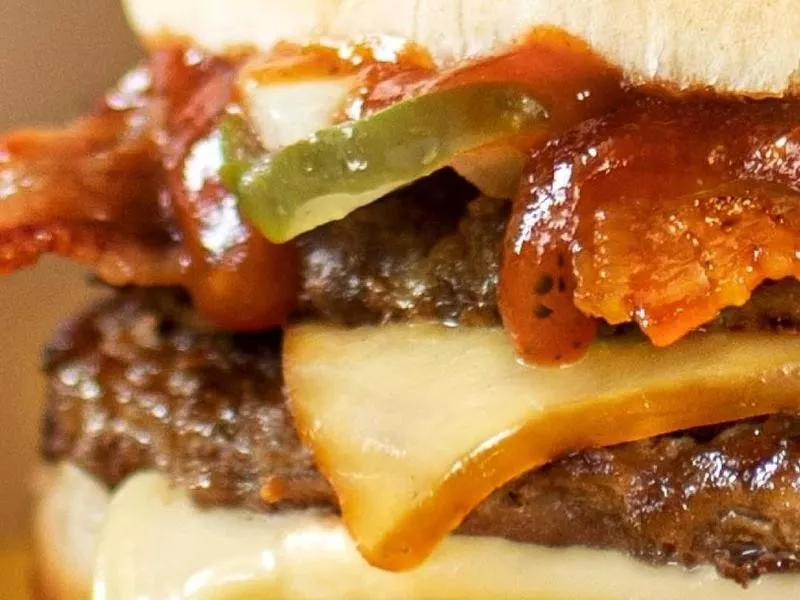Americans eat about 50 billion burgers per year. Put another way, that’s three burgers per week for every man, woman and child. Put still another way, that’s about 153 burgers per year, per person. And put another way, that’s a lot of burgers. And while the burger is perhaps the most distinctly American food, its reach is now global with major U.S. chains easily found around the world.
OK, so technically the Germans invented the burger, but it was Americans who perfected it and, later, mass-produced it. Today, burgers account for 40 percent of all sandwiches sold, from the bite-size burgers sold at the nation’s oldest burger chain (White Castle), to the mass-produced and massively profitable versions churned out by the billions (McDonald’s).
The food industry trade journal QSR rates the biggest fast-food chains every year. We broke out 16 chains that make their money on burgers, ranked them by U.S. sales for 2019, then took a deeper dive to figure out the underpinnings of their success. The top three offer no surprises, but tread deeper into the list and you’re likely to find innovative upstarts and maybe even a burger chain you haven’t heard of. Yet.
Bottom Line: Shake Shack
The newest of the chains on this list, Shake Shack was originally a hot dog stand that was part of a 2001 art installation in New York’s Madison Square Park. Upscale restaurant owner Danny Meyer ran the hot dog stand, staffing it with offseason coat check workers from his other — and fancier — restaurants.
The success of the temporary restaurant was so encouraging that Meyer asked the city for a permanent business permit for the location. Meyer, a St. Louis native, based the menu on the burger stands he had loved before moving to New York. He claims to have come up with the menu in “exactly nine minutes” on a napkin, which still hangs in current CEO Randy Garutti’s office.
One thing that wasn’t on that original menu? Bacon. Shake Shack was in business for eight years before it finally put bacon as a burger option on its menu.
Bottom Line: Checkers/Rally’s
Checkers was primarily found in the southeast United States, and Rally’s was primarily found in the Midwest. The two brands merged in 1999 and today offer similar menus despite the different branding of the stores.
Checker’s founder Jim Mattei started his fast-food career at Wendy’s, but when he decided to start his own burger joint, he did something that was unheard of at the time in the industry: Burgers would be made to order instead of using the premade slabs his competitors used.
The current CEO Frances Allen joined the company in 2020. As the former chief executive of Boston Market, she’s brought a lot of fast-food knowledge to the company and has helped change the financial situation at the company. “The business has some outdated assets, some pretty outdated equipment, so we’re addressing that and, at the same time, embracing leading-edge technology at the drive-thru,” she stated last year.
Bottom Line: In-N-Out History

That’s what a hamburger’s all about. innout / Instagram
A chain that only West Coasters get to enjoy. Harry and Esther Snyder were newlyweds when they launched In-N-Out as California’s first drive-through hamburger stand. The chain disputes Jack in the Box’s claim to having been the first to use the two-way intercom system to make the drive through more efficient, claiming Harry Snyder had the idea first.
With a secret menu and Bible verses printed in tiny print on the bottom of its soda cups, In-N-Out has attracted a devoted and star-studded following. Sammy Hagar told the restaurant’s historian that Van Halen ate there “three times a week” while they were working on “5150,” and Paris Hilton explained a 2006 DUI by saying “I was just really hungry and I wanted to have an In-N-Out burger!”
The highest celebrity praise, however, may have come from Julia Child, who once told Larry King that she kept a list of their locations in her purse.
Bottom Line: Carl’s Jr.
Carl’s Jr. started as a Los Angeles hot dog cart owned by Carl and Margaret Karcher. Carl Karcher was a bread truck driver who invested his $15 in savings to get into the then red-hot hot dog cart business.
They eventually expanded to a full-service, sit-down restaurant. The Jr. was added later to limited-service versions of the sit-down restaurant the couple opened and served as the predecessors to the fast-food chain we know today.
Forays into coffee shops and Mexican food failed for Carl’s Jr., but there was an unusual success story from the founder’s relentless innovation streak: wine. In 2006, Carl’s Jr. and the Palms Casino partnered to offer the Combo Meal at the Las Vegas casino. The meal included a Carl’s Jr. Six Dollar Burger, fries and a $6,000 bottle of French Bordeaux.
The chain later partnered with Wally’s Wine & Spirits to come up with a list of wine pairings for its burgers.
Bottom Line: Five Guys
Started by four brothers and their parents (dad was the fifth guy, at least for a while), Five Guys prides itself as a build-to-order burger company that refuses to deliver or advertise. Jerry Murrell used the $70,000 college fund he had set up for the four brothers to start the family-run restaurant.
“They weren’t scholars. … I always liked having my kids around me, so I thought that was a good way to do it,” Murrell has said. He still serves as CEO.
A year after the first store opened, a fifth son was born. Jerry Murrell has maintained the Five Guys in the name refers to his five sons ever since youngest son Tyler came along.
Bottom Line: Culver’s
In addition to its frozen custard, this Wisconsin-based chain is known for its “ButterBurgers.” The family-owned company developed a menu paying homage to Wisconsin’s dairy farming culture. Hence, lots of cheese and lots of butter on the burger.
But Culver’s also owes a hat tip to McDonald’s. Co-founder Craig Culver swore he would never work in the food industry after spending his childhood working in other restaurants the family owned. But his biology degree didn’t land him a job after he graduated from college, so he took a job as an assistant manager at McDonald’s. From there, he convinced his parents to back his plan to launch Culver’s.
The ButterBurger idea came from a defunct Milwaukee restaurant called the Milky Way. A friend told Craig Culver about the burger, and Culver spent weeks experimenting with the idea in the kitchen of the original Culver’s.
Bottom Line: Hardee’s
For our purposes, we’re separating Hardee’s and its sibling, Carl’s Jr. While they have the same parent company, they are run as separate chains with Hardee’s founded in Greenville in 1960 by Wilbur Hardee.
Hardees grew to the fourth largest fast-food chain by the mid-1990s, expanding in the south and Midwest and targeting towns where there was not already a McDonald’s or Burger King. In 2004, when fast-food chains were under pressure to offer healthier fare, Hardee’s bucked the trend and came up with the Monster Thickburger, a burger that had 1,420 calories and 107 grams of fat.
“This is a burger for young hungry guys who want a really big, delicious, juicy, decadent burger,” then-chief executive Andrew Puzder told CNBC. “I hope our competitors keep promoting those healthy products, and we will keep promoting our big, juicy delicious burgers.”
Bottom Line: Whataburger

Warning: May cause drooling. whataburger / Instagram
Whataburger (one word, no hyphens) is not to be confused with the What-A-Burger chain in the Carolinas, and the menu of the regional company headquartered in San Antonio has expanded in much the same way of national rivals, with chicken and taquitos added.
But when Harmon Dobson opened the first Whataburger, he had but one stated goal: to serve a burger so big that you had to use two hands to eat it. Today, Whataburger boasts 36,864 ways you can order its burger. You can try them all if you eat three a day for the next 33 years.
There’s also a conspiracy theory about the numbers 1 through 5 stamped on its ketchup packets, which the company says are strictly for quality control. Despite Whataburger’s assertion that there is no difference, fans insist the lower the number, the more vinegar in the ketchup. The ketchup packets have their own Facebook page with more than 20,000 likes.
Bottom Line: Sonic Drive-In
Sonic started out as a root beer stand. When Troy Smith saw the success of the car-to-kitchen intercom system, he ditched interest in his other restaurants, including diners and steakhouses.
The company’s emphasis on burgers, however, can be traced back to an unusual provision in its first franchisee agreement. Instead of collecting a flat fee, Smith was paid one cent for every logo-stamped paper hamburger bag that was used.
Today, Sonic has more than 3,500 locations in 45 states and serves 3 million customers per day. And while burgers may have laid the foundation for the chain’s success, the company says its fountain drink system and more than 1 million drink combinations are the best-selling menu item.
Bottom Line: McDonald’s
Combine the next nine most popular burger joints on our list into one company, and they still wouldn’t sell as many burgers in a year as McDonald’s.
McDonald’s claims that it sells 75 burgers every single second of every single minute of every single day. Of the 22 sandwiches that regularly rotate onto the McDonald’s menu, 14 are burgers (or, increasingly, double burgers).
In 2018, in an effort to keep up with consumer trends, the company announced that its seven burgers — hamburger, cheeseburger, McDouble, Quarter Pounder with Cheese, Double Quarter Pounder with Cheese and Big Mac — would no longer contain artificial preservatives, flavors and colors. But don’t get too excited: The pickles still contain an artificial preservative.
See all of the top fast-food chains in America.
How well do you American restaurants? Test your knowledge with this top U.S. restaurant chains quiz from Huge Quiz.